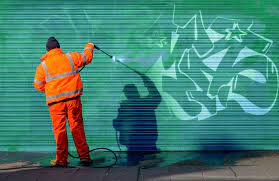Graffiti is a form of vandalism, which has been regarded as a sign of urban decay and a threat to the property values within an area. Most governments consider graffiti to be harmful and have banned it. Local governments are responsible for graffiti removal because graffiti is most often found in public places.
It all depends on the type of surface you are dealing with (masonry, concrete or metal, wood, etc.). Depending on the type of graffiti you are dealing with and the surface it is, there may be multiple ways to answer the question “How to remove graffiti“. Because each substrate or surface is composed of different components that interact with graffiti in different ways. The most effective way to remove graffiti is also different.
Spray paints are used for graffiti. While a variety of solvents and paint strippers can dissolve or break down these paints, some paints may stain or permanently discolor masonry surfaces if they are not used properly. The remaining paint can become difficult or impossible to remove. Graffiti can be permanently damaged by using chemicals or abrasives, which may cause more damage than graffiti.
A solvent is a liquid that dissolves another substance. The right solvent can make your job easier. Choosing the wrong solvent could cause damage to tools or cause problems with a project. It is important to be knowledgeable about the best solvents, how to use them, where they can be found, and when they should be used. This will help avoid costly mistakes. The more graffiti is left to dry, the more powerful the solvent will be and the more difficult it will be to clean up. You have the power of time, so don’t wait to remove it!
Methods to Clean Bricks Graffiti & Vandalism
It is crucial that graffiti and vandalism are dealt with promptly by business owners. It might seem difficult to remove graffiti. Abrasive blasting can be used to remove graffiti from various surfaces.
- Use Abrasive Blasting for Graffiti Cleaning
Abrasive blasting is the application of an extremely pressurized stream abrasive material to clean a substrate. Although the terms “abrasive blasting” and “sandblasting are often used interchangeably, sandblasting requires more materials than abrasive blasting. Dry sandblasting can cause environmental damage by emitting silica or other abrasive materials. Instead, you can use abrasive blasting techniques that utilize glass beads, plastics, and biodegradable media blasting to remove graffiti.
- Masonry paint stripper
First, prepare the brick surface with a masonry paint stripper. Next, use a soft brush to remove graffiti. You will need to start at one corner of the brick wall and work your way down. Continue this process until you have covered all of the affected areas.
- Laser cleaning
Lasers are very effective in removing paint from masonry. Laser cleaning has many benefits, including its selectivity, ability to remove graffiti gradually, repeatability, control over the treated area, and low environmental impact. Laser cleaning can cause scratches to the surface. It has also been known that it can darken or stain some stone surfaces. A professional must be certified to use lasers for laser cleaning.
- Use Solvents for Steel & Other Metals
Although solvents can cause damage to wood, they are ideal for vandalized mailboxes and steel doors, utility boxes, etc. Apply a small amount to the area and rub with steel wool. Protect your eyes and wear gloves. Brick can be easily damaged, despite its rugged appearance. You can remove graffiti from brick using gentler, natural walnut shells or corn cobs. Fine glass beads abrasives are better suited for more difficult jobs. The beads will not cause brick to look rougher because it already has a rough profile.
- Professional Washing Services
Brick & mortar surfaces should be pressured between 2,000 and 3,000 PSI. A 25-degree nozzle tip should be kept approximately 2 feet away from the surface. For older brick surfaces, soft washing is recommended. Start at the top and work your way down. Adjust the pressure as graffiti begins to fade.
- Removing waste that is environmentally sustainable
This involves the use of organic products to remove graffiti from the surface. This method is often cheaper than chemical or paint-out methods and has the advantage of a lower safety and health risk. Dry Ice Blasting or Baking Soda is an eco-friendly method to remove graffiti. The process uses abrasive particles to remove paint safely and without damaging surfaces. Concrete, brick, stone, and wood are all good surfaces for blasting.
- Biodegradable Emulsifier
The most difficult surfaces to remove graffiti from are unpainted brick surfaces. We recommend professional cleaning for brick surfaces, particularly red brick. This reduces the damage to the surface. A very rough surface can be too difficult to treat with solvents and wire brushes. The final job will still show some graffiti evidence.
Last Thoughts
It can be very distressing to see graffiti on your walls or other wall surfaces. These methods can be used to restore graffiti damage to your business or home.


Comments are closed